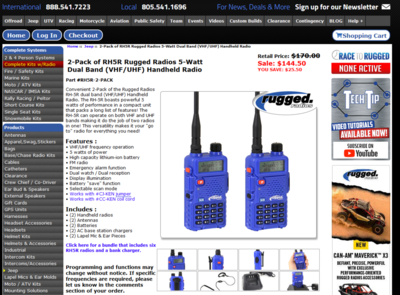Here is some info from the Baofeng Website suprisingly:
Which Two-Way Radio Service is Right for You?
Choosing the right two-way radio can be confusing. You can't just buy a pair of radios and start talking on them. Most two-way radio services require licensing of some sort, and radios designed to be used in those radio services must be certified by the FCC. The most popular two-way radio services are:
- Private Land Mobile Radio Service (PLMRS)
-
- General Mobile Radio Service (GMRS)
-
- Multi-Use Radio Service (MURS)
-
- Amateur Radio Service (ARS)
Private Land Mobile Radio Services(PLMRS)
The Private Land Mobile Radio Servicesis used by public safety agencies, utilities, railroads, manufacturers, and other businesses to meet many different communication needs. Frequencies include:
- 30 −50 MHz (Low Band or Low VHF Band)
-
- 150 −172 MHz (High Band or High VHF Band)
-
- 450 − 470 MHz ( UHF). Some urban areas have additional UHF frequencies from 470 − 490 MHz, and 490 − 512 MHz.
Low band radios have more range than VHF or UHF radios, but require larger antennas. VHF radios work well in outdoor environments, while UHF radios often perform better in urban environments, inside buildings, and when both indoor and outdoor users must communicate with one another.
Commercial, public safety, and government users must obtain an FCC license to use PLMRS radios. When you obtain a license, you're assigned specific frequencies, and the radios you use must be used only on those frequencies. The radios require an FCC Part 90 certification, and are not programmable by end users.
We recommend the BTECH UV-82C for PLMRS use. This radio is Part 90 certified and can be used on both VHF High Band and UHF frequencies. Its features make it an excellent choice for PLMRS use.
General Mobile Radio Service (GMRS)
The General Mobile Radio Service is a service available to individual users (no licenses will be granted to businesses, organizations or other entities). The GMRS uses channels around 462 MHz and 467 MHz. The most common use of GMRS channels is for short-distance, two-way voice communications using hand-held radios, mobile radios and repeater systems. In 2017, the FCC expanded the GMRS to also allow short data messaging applications including text messaging and GPS location information.
To use GMRS radios, you need to apply for a license (no test required) that costs $70 for 10 years. This license covers the licensee (must be an adult) and his or her immediate and extended family members. The licensee's GMRS system may consist of one or more transmitting units (stations).
GMRS radios must be certified to FCC Part 95A or 95E specifications. They are generally preprogrammed to the GMRS channels and may include some Family Radio Service (FRS) channels.
We suggest the BTECH GMRS-V1 for use on GMRS frequencies. It comes with GMRS two-way and GMRS repeater channels pre-programmed, and its many features make it very easy to use.
Multi-Use Radio Service (MURS)
In the United States, the Multi-Use Radio Service is an unlicensed, two-way radio service. Established by the FCC in 2000, MURS radios have a power limit of 2 W, may not be connected to the public telephone network, or used with repeaters. This makes them suitable for only very short-range applications.
MURS radios require Part 95J certification and are generally locked to MURS channels only.
We recommend the BTECH MURS-V1. It is very easy to use—even for young family members. The radios display the actual frequencies and CTCSS tones (aka PL tones or privacy codes) the radio is transmitting, unlike children's FRS walkie talkies.
Amateur Radio Service (ARS)
Amateur radio operators can use many different frequencies, including HF, VHF, and UHF frequencies. In the VHF and UHF range, the amateur radio bands include:
- 6 m: 50 – 54 MHz
-
- 2 m: 144 – 148 MHz
-
- 1.25 m: 222 – 225 MHz
-
- 70 cm: 420 – 450 MHz
-
- 33 cm: 902 – 928 MHz
To use amateur radio equipment, you need to pass a license test (the license is free but there can be a fee for administering the exam). More information about how to become a licensed radio amateur, can be found on the
American Radio Relay League website. Radios used in the ARS must at minimum be Part 15B certified.
We recommend the BTECH UV-5X3 for amateur radio use. It is a tri-band radio that can be operated on the 2 m, 1.25 m, and 70 cm amateur radio bands.



